ExamTopics Az-104 Questions 1-100
1/99
There's no tags or description
Looks like no tags are added yet.
Name | Mastery | Learn | Test | Matching | Spaced |
|---|
No study sessions yet.
100 Terms
Your company has several departments. Each department has a number of virtual machines (VMs).
The company has an Azure subscription that contains a resource group named RG1.
All VMs are located in RG1.
You want to associate each VM with its respective department.
What should you do?
A. Create Azure Management Groups for each department.
B. Create a resource group for each department.
C. Assign tags to the virtual machines.
D. Modify the settings of the virtual machines.
C. Assign tags to the virtual machines.
Your company has an Azure Active Directory (Azure AD) subscription.
You want to implement an Azure AD conditional access policy.
The policy must be configured to require members of the Global Administrators group to use Multi-Factor Authentication and an Azure AD-joined device when they connect to Azure AD from untrusted locations.
Solution: You access the multi-factor authentication page to alter the user settings.
Does the solution meet the goal?
A. Yes
B. No
B. No
Your company has an Azure Active Directory (Azure AD) subscription.
You want to implement an Azure AD conditional access policy.
The policy must be configured to require members of the Global Administrators group to use Multi-Factor Authentication and an Azure AD-joined device when they connect to Azure AD from untrusted locations.
Solution: You access the Azure portal to alter the session control of the Azure AD conditional access policy.
Does the solution meet the goal?
A. Yes
B. No
B. No
Your company has an Azure Active Directory (Azure AD) subscription.
You want to implement an Azure AD conditional access policy.
The policy must be configured to require members of the Global Administrators group to use Multi-Factor Authentication and an Azure AD-joined device when they connect to Azure AD from untrusted locations.
Solution: You access the Azure portal to alter the grant control of the Azure AD conditional access policy.
Does the solution meet the goal?
A. Yes
B. No
A. Yes
You are planning to deploy an Ubuntu Server virtual machine to your company's Azure subscription.
You are required to implement a custom deployment that includes adding a particular trusted root certification authority (CA).
Which of the following should you use to create the virtual machine?
A. The New-AzureRmVm cmdlet.
B. The New-AzVM cmdlet.
C. The Create-AzVM cmdlet.
D. The az vm create command.
D. The az vm create command.
Your company makes use of Multi-Factor Authentication for when users are not in the office. The Per Authentication option has been configured as the usage model.
After the acquisition of a smaller business and the addition of the new staff to Azure Active Directory (Azure AD) obtains a different company and adding the new employees to Azure Active Directory (Azure AD), you are informed that these employees should also make use of Multi-Factor Authentication.
To achieve this, the Per Enabled User setting must be set for the usage model.
Solution: You reconfigure the existing usage model via the Azure portal.
Does the solution meet the goal?
A. Yes
B. No
B. No
Your company's Azure solution makes use of Multi-Factor Authentication for when users are not in the office. The Per Authentication option has been configured as the usage model.
After the acquisition of a smaller business and the addition of the new staff to Azure Active Directory (Azure AD) obtains a different company and adding the new employees to Azure Active Directory (Azure AD), you are informed that these employees should also make use of Multi-Factor Authentication.
To achieve this, the Per Enabled User setting must be set for the usage model.
Solution: You reconfigure the existing usage model via the Azure CLI.
Does the solution meet the goal?
A. Yes
B. No
B. No
Your company's Azure solution makes use of Multi-Factor Authentication for when users are not in the office. The Per Authentication option has been configured as the usage model.
After the acquisition of a smaller business and the addition of the new staff to Azure Active Directory (Azure AD) obtains a different company and adding the new employees to Azure Active Directory (Azure AD), you are informed that these employees should also make use of Multi-Factor Authentication.
To achieve this, the Per Enabled User setting must be set for the usage model.
Solution: You create a new Multi-Factor Authentication provider with a backup from the existing Multi-Factor Authentication provider data.
Does the solution meet the goal?
A. Yes
B. No
B. No
Your company has an Azure Active Directory (Azure AD) tenant named weyland.com that is configured for hybrid coexistence with the on-premises Active
Directory domain.
You have a server named DirSync1 that is configured as a DirSync server.
You create a new user account in the on-premise Active Directory. You now need to replicate the user information to Azure AD immediately.
Solution: You run the Start-ADSyncSyncCycle -PolicyType Initial PowerShell cmdlet.
Does the solution meet the goal?
A. Yes
B. No
B. No
Your company has an Azure Active Directory (Azure AD) tenant named weyland.com that is configured for hybrid coexistence with the on-premises Active
Directory domain.
You have a server named DirSync1 that is configured as a DirSync server.
You create a new user account in the on-premise Active Directory. You now need to replicate the user information to Azure AD immediately.
Solution: You use Active Directory Sites and Services to force replication of the Global Catalog on a domain controller.
Does the solution meet the goal?
A. Yes
B. No
B. No
Your company has an Azure Active Directory (Azure AD) tenant named weyland.com that is configured for hybrid coexistence with the on-premises Active
Directory domain.
You have a server named DirSync1 that is configured as a DirSync server.
You create a new user account in the on-premise Active Directory. You now need to replicate the user information to Azure AD immediately.
Solution: You restart the NetLogon service on a domain controller.
Does the solution meet the goal?
A. Yes
B. No
B. No
Your company has a Microsoft Azure subscription.
The company has datacenters in Los Angeles and New York.
You are configuring the two datacenters as geo-clustered sites for site resiliency.
You need to recommend an Azure storage redundancy option.
You have the following data storage requirements:
✑ Data must be stored on multiple nodes.
✑ Data must be stored on nodes in separate geographic locations.
✑ Data can be read from the secondary location as well as from the primary location.
Which of the following Azure stored redundancy options should you recommend?
A. Geo-redundant storage
B. Read-only geo-redundant storage
C. Zone-redundant storage
D. Locally redundant storage
B. Read-only geo-redundant storage
Your company has an azure subscription that includes a storage account, a resource group, a blob container and a file share.
A colleague named Jon Ross makes use of a solitary Azure Resource Manager (ARM) template to deploy a virtual machine and an additional Azure Storage account.
You want to review the ARM template that was used by Jon Ross.
Solution: You access the Virtual Machine blade.
Does the solution meet the goal?
A. Yes
B. No
B. No
Your company has an azure subscription that includes a storage account, a resource group, a blob container and a file share.
A colleague named Jon Ross makes use of a solitary Azure Resource Manager (ARM) template to deploy a virtual machine and an additional Azure Storage account.
You want to review the ARM template that was used by Jon Ross.
Solution: You access the Resource Group blade.
Does the solution meet the goal?
A. Yes
B. No
A. Yes
Your company has an azure subscription that includes a storage account, a resource group, a blob container and a file share.
A colleague named Jon Ross makes use of a solitary Azure Resource Manager (ARM) template to deploy a virtual machine and an additional Azure Storage account.
You want to review the ARM template that was used by Jon Ross.
Solution: You access the Container blade.
Does the solution meet the goal?
A. Yes
B. No
B. No
Your company has three virtual machines (VMs) that are included in an availability set.
You try to resize one of the VMs, which returns an allocation failure message.
It is imperative that the VM is resized.
Which of the following actions should you take?
A. You should only stop one of the VMs.
B. You should stop two of the VMs.
C. You should stop all three VMs.
D. You should remove the necessary VM from the availability set.
C. You should stop all three VMs.
You have an Azure virtual machine (VM) that has a single data disk. You have been tasked with attaching this data disk to another Azure VM.
You need to make sure that your strategy allows for the virtual machines to be offline for the least amount of time possible.
Which of the following is the action you should take FIRST?
A. Stop the VM that includes the data disk
B. Stop the VM that the data disk must be attached to.
C. Detach the data disk.
D. Delete the VM that includes the data disk.
C. Detach the data disk.
Your company has an Azure subscription.
You need to deploy a number of Azure virtual machines (VMs) using Azure Resource Manager (ARM) templates. You have been informed that the VMs will be included in a single availability set.
You are required to make sure that the ARM template you configure allows for as many VMs as possible to remain accessible in the event of fabric failure or maintenance.
Which of the following is the value that you should configure for the platformFaultDomainCount property?
A. 10
B. 30
C. Min Value
D. Max Value
D. Max Value
Your company has an Azure subscription.
You need to deploy a number of Azure virtual machines (VMs) using Azure Resource Manager (ARM) templates. You have been informed that the VMs will be included in a single availability set.
You are required to make sure that the ARM template you configure allows for as many VMs as possible to remain accessible in the event of fabric failure or maintenance.
Which of the following is the value that you should configure for the platformUpdateDomainCount property?
A. 10
B. 20
C. 30
D. 40
B. 20

You have downloaded an Azure Resource Manager (ARM) template to deploy numerous virtual machines (VMs). The ARM template is based on a current VM, but must be adapted to reference an administrative password.
You need to make sure that the password cannot be stored in plain text.
You are preparing to create the necessary components to achieve your goal.
Which of the following should you create to achieve your goal? Answer by dragging the correct option from the list to the answer area.
Select and Place:
An Azure Key Vault
An access policy(legacy) / RBAC
Your company has an Azure Active Directory (Azure AD) tenant that is configured for hybrid coexistence with the on-premises Active Directory domain.
The on-premise virtual environment consists of virtual machines (VMs) running on Windows Server 2012 R2 Hyper-V host servers.
You have created some PowerShell scripts to automate the configuration of newly created VMs. You plan to create several new VMs.
You need a solution that ensures the scripts are run on the new VMs.
Which of the following is the best solution?
A. Configure a SetupComplete.cmd batch file in the %windir%\setup\scripts directory.
B. Configure a Group Policy Object (GPO) to run the scripts as logon scripts.
C. Configure a Group Policy Object (GPO) to run the scripts as startup scripts.
D. Place the scripts in a new virtual hard disk (VHD).
A. Configure a SetupComplete.cmd batch file in the %windir%\setup\scripts directory.
Your company has an Azure Active Directory (Azure AD) tenant that is configured for hybrid coexistence with the on-premises Active Directory domain.
You plan to deploy several new virtual machines (VMs) in Azure. The VMs will have the same operating system and custom software requirements.
You configure a reference VM in the on-premise virtual environment. You then generalize the VM to create an image.
You need to upload the image to Azure to ensure that it is available for selection when you create the new Azure VMs.
Which PowerShell cmdlets should you use?
A. Add-AzVM
B. Add-AzVhd
C. Add-AzImage
D. Add-AzImageDataDisk
B. Add-AzVhd

Your company has an Azure subscription that includes a number of Azure virtual machines (VMs), which are all part of the same virtual network.
Your company also has an on-premises Hyper-V server that hosts a VM, named VM1, which must be replicated to Azure.
Which of the following objects that must be created to achieve this goal? Answer by dragging the correct option from the list to the answer area.
Select and Place:
Hyper-V Site
Azure Recovery Services Vault
Azure Policy
Your company's Azure subscription includes two Azure networks named VirtualNetworkA and VirtualNetworkB.
VirtualNetworkA includes a VPN gateway that is configured to make use of static routing. Also, a site-to-site VPN connection exists between your company's on- premises network and VirtualNetworkA.
You have configured a point-to-site VPN connection to VirtualNetworkA from a workstation running Windows 10. After configuring virtual network peering between
VirtualNetworkA and VirtualNetworkB, you confirm that you are able to access VirtualNetworkB from the company's on-premises network. However, you find that you cannot establish a connection to VirtualNetworkB from the Windows 10 workstation.
You have to make sure that a connection to VirtualNetworkB can be established from the Windows 10 workstation.
Solution: You choose the Allow gateway transit setting on VirtualNetworkA.
Does the solution meet the goal?
A. Yes
B. No
B. No
Your company's Azure subscription includes two Azure networks named VirtualNetworkA and VirtualNetworkB.
VirtualNetworkA includes a VPN gateway that is configured to make use of static routing. Also, a site-to-site VPN connection exists between your company's on- premises network and VirtualNetworkA.
You have configured a point-to-site VPN connection to VirtualNetworkA from a workstation running Windows 10. After configuring virtual network peering between
VirtualNetworkA and VirtualNetworkB, you confirm that you are able to access VirtualNetworkB from the company's on-premises network. However, you find that you cannot establish a connection to VirtualNetworkB from the Windows 10 workstation.
You have to make sure that a connection to VirtualNetworkB can be established from the Windows 10 workstation.
Solution: You choose the Allow gateway transit setting on VirtualNetworkB.
Does the solution meet the goal?
A. Yes
B. No
B. No
Your company's Azure subscription includes two Azure networks named VirtualNetworkA and VirtualNetworkB.
VirtualNetworkA includes a VPN gateway that is configured to make use of static routing. Also, a site-to-site VPN connection exists between your company's on- premises network and VirtualNetworkA.
You have configured a point-to-site VPN connection to VirtualNetworkA from a workstation running Windows 10. After configuring virtual network peering between
VirtualNetworkA and VirtualNetworkB, you confirm that you are able to access VirtualNetworkB from the company's on-premises network. However, you find that you cannot establish a connection to VirtualNetworkB from the Windows 10 workstation.
You have to make sure that a connection to VirtualNetworkB can be established from the Windows 10 workstation.
Solution: You download and re-install the VPN client configuration package on the Windows 10 workstation.
Does the solution meet the goal?
A. Yes
B. No
A. Yes
Your company has virtual machines (VMs) hosted in Microsoft Azure. The VMs are located in a single Azure virtual network named VNet1.
The company has users that work remotely. The remote workers require access to the VMs on VNet1.
You need to provide access for the remote workers.
What should you do?
A. Configure a Site-to-Site (S2S) VPN.
B. Configure a VNet-toVNet VPN.
C. Configure a Point-to-Site (P2S) VPN.
D. Configure DirectAccess on a Windows Server 2012 server VM.
E. Configure a Multi-Site VPN
C. Configure a Point-to-Site (P2S) VPN.
Your company has a Microsoft SQL Server Always On availability group configured on their Azure virtual machines (VMs).
You need to configure an Azure internal load balancer as a listener for the availability group.
Solution: You create an HTTP health probe on port 1433.
Does the solution meet the goal?
A. Yes
B. No
B. No
TCP would work on port 1433
Your company has a Microsoft SQL Server Always On availability group configured on their Azure virtual machines (VMs).
You need to configure an Azure internal load balancer as a listener for the availability group.
Solution: You set Session persistence to Client IP.
Does the solution meet the goal?
A. Yes
B. No
B. No
Your company has a Microsoft SQL Server Always On availability group configured on their Azure virtual machines (VMs).
You need to configure an Azure internal load balancer as a listener for the availability group.
Solution: You enable Floating IP.
Does the solution meet the goal?
A. Yes
B. No
A. Yes
Your company has two on-premises servers named SRV01 and SRV02. Developers have created an application that runs on SRV01. The application calls a service on SRV02 by IP address.
You plan to migrate the application on Azure virtual machines (VMs). You have configured two VMs on a single subnet in an Azure virtual network.
You need to configure the two VMs with static internal IP addresses.
What should you do?
A. Run the New-AzureRMVMConfig PowerShell cmdlet.
B. Run the Set-AzureSubnet PowerShell cmdlet.
C. Modify the VM properties in the Azure Management Portal.
D. Modify the IP properties in Windows Network and Sharing Center.
E. Run the Set-AzureStaticVNetIP PowerShell cmdlet.
C. Modify the VM properties in the Azure Management Portal.
Set-AzNetworkInterface is the updated cmdlet
Your company has an Azure Active Directory (Azure AD) subscription.
You need to deploy five virtual machines (VMs) to your company's virtual network subnet.
The VMs will each have both a public and private IP address. Inbound and outbound security rules for all of these virtual machines must be identical.
Which of the following is the least amount of network interfaces needed for this configuration?
A. 5
B. 10
C. 20
D. 40
A. 5
Your company has an Azure Active Directory (Azure AD) subscription.
You need to deploy five virtual machines (VMs) to your company's virtual network subnet.
The VMs will each have both a public and private IP address. Inbound and outbound security rules for all of these virtual machines must be identical.
Which of the following is the least amount of security groups needed for this configuration?
A. 4
B. 3
C. 2
D. 1
D. 1
Your company's Azure subscription includes Azure virtual machines (VMs) that run Windows Server 2016. One of the VMs is backed up every day using Azure Backup Instant Restore.
When the VM becomes infected with data encrypting ransomware, you decide to recover the VM's files. Which of the following is TRUE in this scenario?
A. You can only recover the files to the infected VM.
B. You can recover the files to any VM within the company's subscription.
C. You can only recover the files to a new VM.
D. You will not be able to recover the files.
B. You can recover the files to any VM within the company's subscription.
Your company's Azure subscription includes Azure virtual machines (VMs) that run Windows Server 2016.
One of the VMs is backed up every day using Azure Backup Instant Restore.
When the VM becomes infected with data encrypting ransomware, you are required to restore the VM.
Which of the following actions should you take?
A. You should restore the VM after deleting the infected VM.
B. You should restore the VM to any VM within the company's subscription.
C. You should restore the VM to a new Azure VM.
D. You should restore the VM to an on-premise Windows device.
C. You should restore the VM to a new Azure VM.
You administer a solution in Azure that is currently having performance issues.
You need to find the cause of the performance issues pertaining to metrics on the Azure infrastructure.
Which of the following is the tool you should use?
A. Azure Traffic Analytics
B. Azure Monitor
C. Azure Activity Log
D. Azure Advisor
B. Azure Monitor
Your company has an Azure subscription that includes a Recovery Services vault.
You want to use Azure Backup to schedule a backup of your company's virtual machines (VMs) to the Recovery Services vault.
Which of the following VMs can you back up? Choose all that apply.
A. VMs that run Windows 10.
B. VMs that run Windows Server 2012 or higher.
C. VMs that have NOT been shut down.
D. VMs that run Debian 8.2+.
E. VMs that have been shut down.
ABCDE
You have an Azure Active Directory (Azure AD) tenant named contoso.com.
You have a CSV file that contains the names and email addresses of 500 external users.
You need to create a guest user account in contoso.com for each of the 500 external users.
Solution: You create a PowerShell script that runs the New-AzureADUser cmdlet for each user.
Does this meet the goal?
A. Yes
B. No
B. No
You have an Azure Active Directory (Azure AD) tenant named contoso.com.
You have a CSV file that contains the names and email addresses of 500 external users.
You need to create a guest user account in contoso.com for each of the 500 external users.
Solution: From Azure AD in the Azure portal, you use the Bulk create user operation.
Does this meet the goal?
A. Yes
B. No
B. No
You have an Azure Active Directory (Azure AD) tenant named contoso.com.
You have a CSV file that contains the names and email addresses of 500 external users.
You need to create a guest user account in contoso.com for each of the 500 external users.
Solution: You create a PowerShell script that runs the New-AzureADMSInvitation cmdlet for each external user.
Does this meet the goal?
A. Yes
B. No
A. Yes
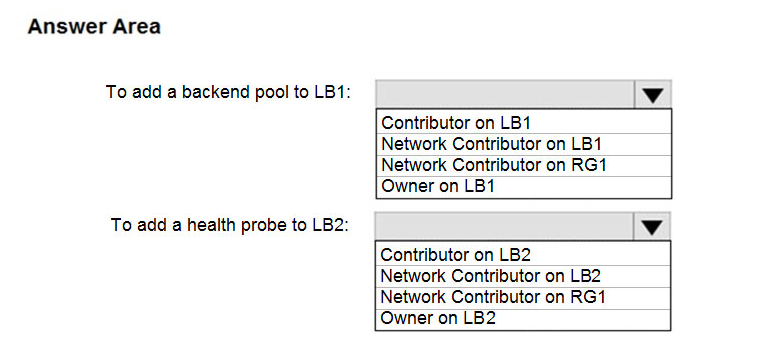
You have an Azure subscription named Subscription1 that contains a resource group named RG1.
In RG1, you create an internal load balancer named LB1 and a public load balancer named LB2.
You need to ensure that an administrator named Admin1 can manage LB1 and LB2. The solution must follow the principle of least privilege.
Which role should you assign to Admin1 for each task? To answer, select the appropriate options in the answer area.
Network Contributor on LB1
Network Contributor on LB2
You have a Microsoft 365 tenant and an Azure Active Directory (Azure AD) tenant named contoso.com.
You plan to grant three users named User1, User2, and User3 access to a temporary Microsoft SharePoint document library named Library1.
You need to create groups for the users. The solution must ensure that the groups are deleted automatically after 180 days.
Which two groups should you create? Each correct answer presents a complete solution.
A. a Microsoft 365 group that uses the Assigned membership type
B. a Security group that uses the Assigned membership type
C. a Microsoft 365 group that uses the Dynamic User membership type
D. a Security group that uses the Dynamic User membership type
E. a Security group that uses the Dynamic Device membership type
A. a Microsoft 365 group that uses the Assigned membership type
C. a Microsoft 365 group that uses the Dynamic User membership type
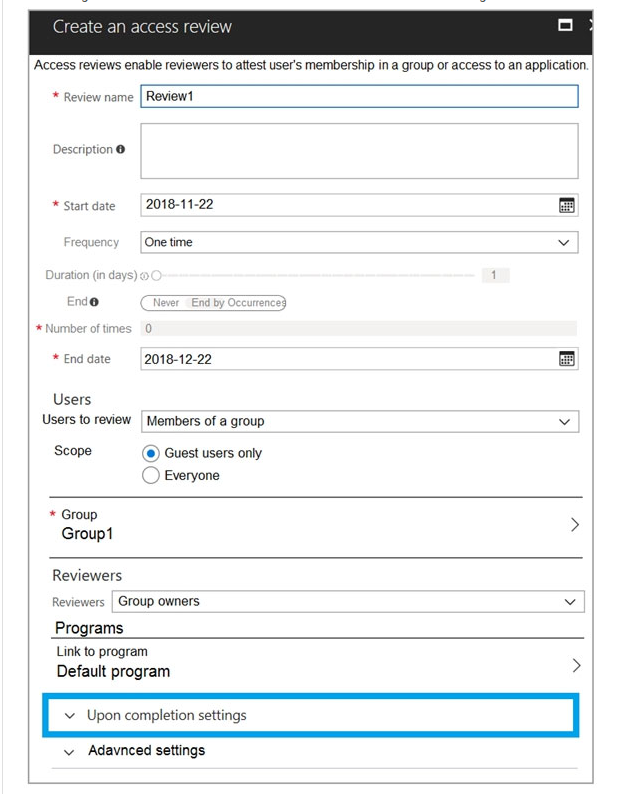
You have an Azure Active Directory (Azure AD) tenant named contoso.com that contains the users shown in the following table:
Name | Type | Member of |
User1 | Member | Group1 |
User2 | Guest | Group1 |
User3 | Member | None |
UserA | Member | Group2 |
UserB | Guest | Group2 |

User3 is the owner of Group1.
Group2 is a member of Group1.
You configure an access review named Review1 as shown in the following exhibit(1st pic):
For each of the following statements, select Yes if the statement is true. Otherwise, select No. (2nd pic)
No
No
No

You have the Azure management groups shown in the following table:
Name | In management group |
Tenant Root Group | Not applicable |
ManagementGroup11 | Tenant Root Group |
ManagementGroup12 | Tenant Root Group |
ManagementGroup21 | ManagementGroup11  |
You add Azure subscriptions to the management groups as shown in the following table:
Name | Management group |
Subscription1 | ManagementGroup21 |
Subscription2 | ManagementGroup12  |
You create the Azure policies shown in the following table:
Name | Parameter | Scope |
Not allowed resource types | virtualNetworks | Tenant Root Group |
Allowed resource types | virtualNetworks | ManagementGroup12  |
For each of the following statements, select Yes if the statement is true. Otherwise, select No.
No
Yes
Yes
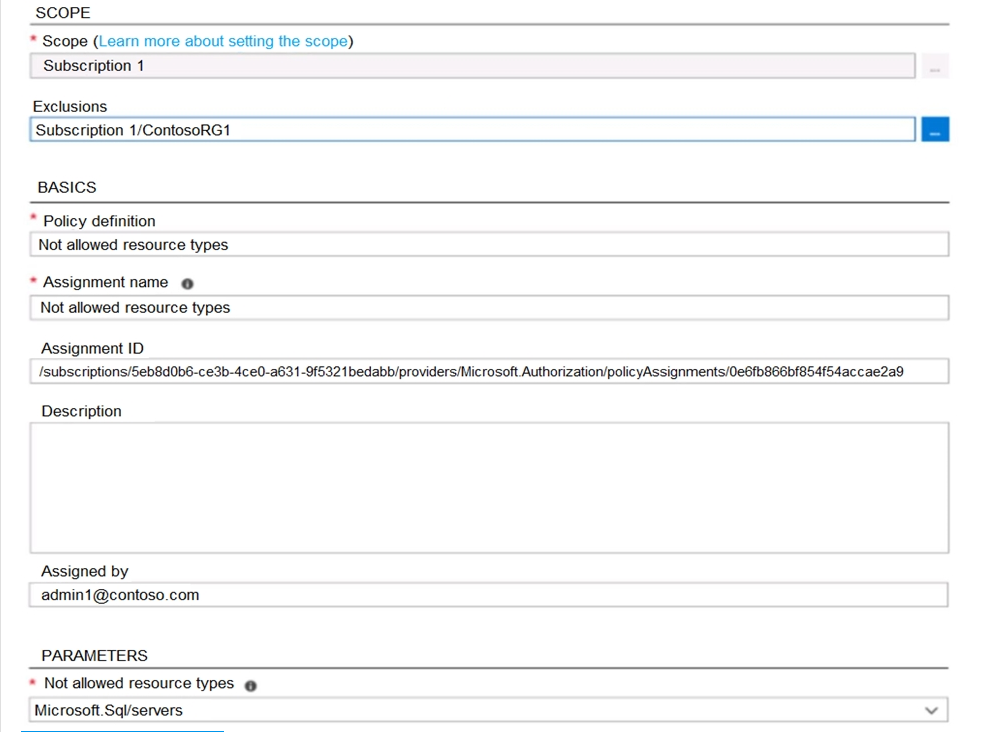
You have an Azure policy as shown in the following exhibit:
What is the effect of the policy?
A. You are prevented from creating Azure SQL servers anywhere in Subscription 1.
B. You can create Azure SQL servers in ContosoRG1 only.
C. You are prevented from creating Azure SQL Servers in ContosoRG1 only.
D. You can create Azure SQL servers in any resource group within Subscription 1.
C. You are prevented from creating Azure SQL Servers in ContosoRG1 only.

You have an Azure subscription that contains the resources shown in the following table:
Name | Type | Resource group | Tag |
RG6 | Resource group | Not applicable | None |
VNET1 | Virtual network | RG6 | Department: D1  |
You assign a policy to RG6 as shown in the following table:
Section | Setting | Value |
Scope | Scope | Subscription1/RG6 |
Exclusions | None | |
Basics | Policy definition | Apply tag and its default value |
Assignment name | Apply tag and its default value | |
Parameters | Tag name | Label |
Tag value | Value1  |
To RG6, you apply the tag: RGroup: RG6.
You deploy a virtual network named VNET2 to RG6.
Which tags apply to VNET1 and VNET2? To answer, select the appropriate options in the answer area.
VNet1:
Department: D1 only
VNet2:
Label: Value1 only
You have an Azure subscription named AZPT1 that contains the resources shown in the following table:
Name | Type |
storage1 | Azure Storage account |
VNET1 | Virtual network |
VM1 | Azure virtual machine |
VM1Managed | Managed disk for VM1 |
RVault1 | Recovery Services vault for the site recovery of VM1  |
You create a new Azure subscription named AZPT2.
You need to identify which resources can be moved to AZPT2.
Which resources should you identify?
A. VM1, storage1, VNET1, and VM1Managed only
B. VM1 and VM1Managed only
C. VM1, storage1, VNET1, VM1Managed, and RVAULT1
D. RVAULT1 only
C. VM1, storage1, VNET1, VM1Managed, and RVAULT1
You recently created a new Azure subscription that contains a user named Admin1.
Admin1 attempts to deploy an Azure Marketplace resource by using an Azure Resource Manager template. Admin1 deploys the template by using Azure PowerShell and receives the following error message: “User failed validation to purchase resources.”
Error message: “Legal terms have not been accepted for this item on this subscription. To accept legal terms, please go to the Azure portal (http://go.microsoft.com/fwlink/?LinkId=534873) and configure programmatic deployment for the Marketplace item or create it there for the first time.”
You need to ensure that Admin1 can deploy the Marketplace resource successfully.
What should you do?
A. From Azure PowerShell, run the Set-AzApiManagementSubscription cmdlet
B. From the Azure portal, register the Microsoft.Marketplace resource provider
C. From Azure PowerShell, run the Set-AzMarketplaceTerms cmdlet
D. From the Azure portal, assign the Billing administrator role to Admin1
C. From Azure PowerShell, run the Set-AzMarketplaceTerms cmdlet
You have an Azure Active Directory (Azure AD) tenant that contains 5,000 user accounts.
You create a new user account named AdminUser1.
You need to assign the User administrator administrative role to AdminUser1.
What should you do from the user account properties?
A. From the Licenses blade, assign a new license
B. From the Directory role blade, modify the directory role
C. From the Groups blade, invite the user account to a new group
B. From the Directory role blade, modify the directory role
You have an Azure Active Directory (Azure AD) tenant named contoso.onmicrosoft.com that contains 100 user accounts.
You purchase 10 Azure AD Premium P2 licenses for the tenant.
You need to ensure that 10 users can use all the Azure AD Premium features.
What should you do?
A. From the Licenses blade of Azure AD, assign a license
B. From the Groups blade of each user, invite the users to a group
C. From the Azure AD domain, add an enterprise application
D. From the Directory role blade of each user, modify the directory role
A. From the Licenses blade of Azure AD, assign a license
You have an Azure subscription named Subscription1 and an on-premises deployment of Microsoft System Center Service Manager.
Subscription1 contains a virtual machine named VM1.
You need to ensure that an alert is set in Service Manager when the amount of available memory on VM1 is below 10 percent.
What should you do first?
A. Create an automation runbook
B. Deploy a function app
C. Deploy the IT Service Management Connector (ITSM)
D. Create a notification
C. Deploy the IT Service Management Connector (ITSM)
You sign up for Azure Active Directory (Azure AD) Premium P2.
You need to add a user named admin1@contoso.com as an administrator on all the computers that will be joined to the Azure AD domain.
What should you configure in Azure AD?
A. Device settings from the Devices blade
B. Providers from the MFA Server blade
C. User settings from the Users blade
D. General settings from the Groups blade
A. Device settings from the Devices blade

You have Azure Active Directory tenant named Contoso.com that includes following users:
Name | Role |
User1 | Cloud device administrator |
User2 | User administrator  |
Contoso.com includes following Windows 10 devices:
Name | Join type |
Device1 | Azure AD registered |
Device2 | Azure AD joined  |
You create following security groups in Contoso.com:
Name | Membership Type | Owner |
Group1 | Assigned | User2 |
Group2 | Dynamic Device | User2  |
For each of the following statements, select Yes if the statement is true. Otherwise, select No.
No
Yes
No
You have an Azure subscription that contains a resource group named RG26.
RG26 is set to the West Europe location and is used to create temporary resources for a project. RG26 contains the resources shown in the following table.
Name | Type | Location |
VM1 | Virtual machine | North Europe |
RGV1 | Recovery Services vault | North Europe |
SQLD01 | SQL server in Azure VM | North Europe |
sa001 | Storage account | West Europe  |
SQLDB01 is backed up to RGV1.
When the project is complete, you attempt to delete RG26 from the Azure portal. The deletion fails.
You need to delete RG26.
What should you do first?
A. Delete VM1
B. Stop VM1
C. Stop the backup of SQLDB01
D. Delete sa001
C. Stop the backup of SQLDB01
You have an Azure subscription named Subscription1 that contains a virtual network named VNet1. VNet1 is in a resource group named RG1.
Subscription1 has a user named User1. User1 has the following roles:
✑ Reader
✑ Security Admin
✑ Security Reader
You need to ensure that User1 can assign the Reader role for VNet1 to other users.
What should you do?
A. Remove User1 from the Security Reader and Reader roles for Subscription1.
B. Assign User1 the User Access Administrator role for VNet1.
C. Assign User1 the Network Contributor role for VNet1.
D. Assign User1 the Network Contributor role for RG1.
B. Assign User1 the User Access Administrator role for VNet1.
You have an Azure Active Directory (Azure AD) tenant named contosocloud.onmicrosoft.com.
Your company has a public DNS zone for contoso.com.
You add contoso.com as a custom domain name to Azure AD.
You need to ensure that Azure can verify the domain name.
Which type of DNS record should you create?
A. MX
B. NSEC
C. PTR
D. RRSIG
A. MX
You have an Azure Directory (Azure AD) tenant named Adatum and an Azure Subscription named Subscription1. Adatum contains a group named Developers.
Subscription1 contains a resource group named Dev.
You need to provide the Developers group with the ability to create Azure logic apps in the Dev resource group.
Solution: On Subscription1, you assign the DevTest Labs User role to the Developers group.
Does this meet the goal?
A. Yes
B. No
B. No
You have an Azure Directory (Azure AD) tenant named Adatum and an Azure Subscription named Subscription1. Adatum contains a group named Developers.
Subscription1 contains a resource group named Dev.
You need to provide the Developers group with the ability to create Azure logic apps in the Dev resource group.
Solution: On Subscription1, you assign the Logic App Operator role to the Developers group.
Does this meet the goal?
A. Yes
B. No
B. No
You have an Azure Directory (Azure AD) tenant named Adatum and an Azure Subscription named Subscription1. Adatum contains a group named Developers.
Subscription1 contains a resource group named Dev.
You need to provide the Developers group with the ability to create Azure logic apps in the Dev resource group.
Solution: On Dev, you assign the Contributor role to the Developers group.
Does this meet the goal?
A. Yes
B. No
A. Yes
You have an Azure subscription that is used by four departments in your company. The subscription contains 10 resource groups. Each department uses resources in several resource groups.
You need to send a report to the finance department. The report must detail the costs for each department.
Which three actions should you perform in sequence? To answer, move the appropriate actions from the list of actions to the answer area and arrange them in the correct order.
Select and Place:
Assign a tag to a resource group
Assign a tag to each resource
Download the usage report
From the cost analysis blade, filter the view by tag
Open the Resource costs blade of each resource group
Assign a tag to each resource
From the cost analysis blade, filter the view by tag
Download the usage report
You have an Azure subscription named Subscription1 that contains an Azure Log Analytics workspace named Workspace1.
You need to view the error events from a table named Event.
Which query should you run in Workspace1?
A. Get-Event Event | where {$_.EventType == "error"}
B. search in (Event) "error"
C. select * from Event where EventType == "error"
D. search in (Event) * | where EventType -eq "error"
B. search in (Event) "error"
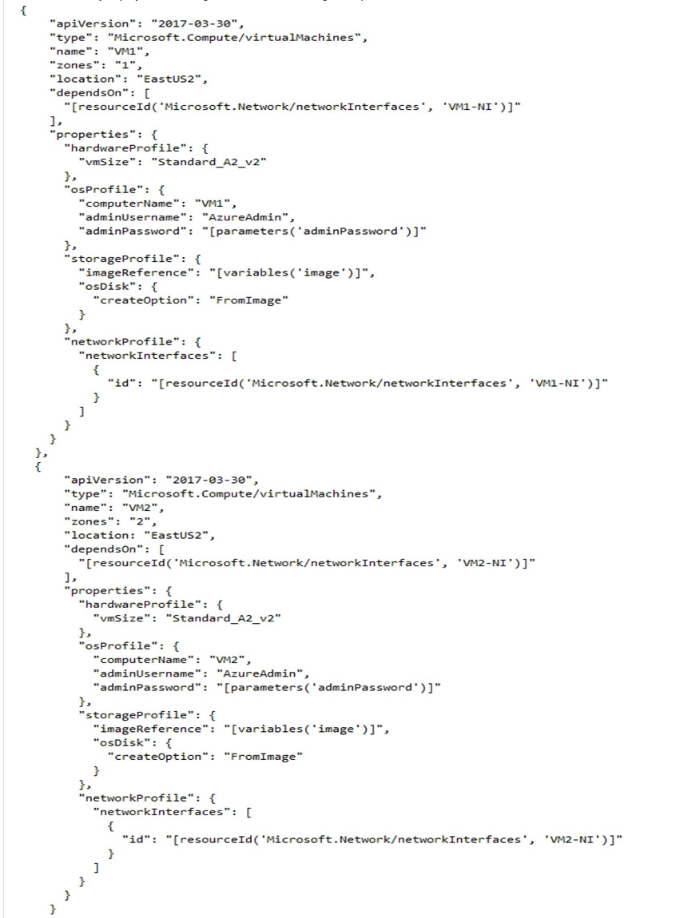
You have an Azure subscription that contains a virtual network named VNET1 in the East US 2 region. A network interface named VM1-NI is connected to
VNET1.
You successfully deploy the following Azure Resource Manager template.
For each of the following statements, select Yes if the statement is true. Otherwise, select No.
VM1 and VM2 can connect to VNET1
If an Azure datacenter becomes unavailable, VM1 or VM2 will be available
If the East US 2 region becomes unavailable, VM1 or VM2 will be unavailable
Yes
Yes
No
You have an Azure subscription named Subscription1. Subscription1 contains the resource groups in the following table.
Name | Azure region | Policy |
RG1 | West Europe | Policy1 |
RG2 | North Europe | Policy2 |
RG3 | France Central | Policy3  |
RG1 has a web app named WebApp1. WebApp1 is located in West Europe.
You move WebApp1 to RG2.
What is the effect of the move?
A. The App Service plan for WebApp1 remains in West Europe. Policy2 applies to WebApp1.
B. The App Service plan for WebApp1 moves to North Europe. Policy2 applies to WebApp1.
C. The App Service plan for WebApp1 remains in West Europe. Policy1 applies to WebApp1.
D. The App Service plan for WebApp1 moves to North Europe. Policy1 applies to WebApp1.
A. The App Service plan for WebApp1 remains in West Europe. Policy2 applies to WebApp1.

You have an Azure subscription named Subscription1 that has a subscription ID of c276fc76-9cd4-44c9-99a7-4fd71546436e.
You need to create a custom RBAC role named CR1 that meets the following requirements:
✑ Can be assigned only to the resource groups in Subscription1
✑ Prevents the management of the access permissions for the resource groups
✑ Allows the viewing, creating, modifying, and deleting of resources within the resource groups
What should you specify in the assignable scopes and the permission elements of the definition of CR1? To answer, select the appropriate options in the answer area.
“/subscriptions/c276fc76-9cd4-44c9-99a7-4fd71546435e/resourceGroups”
“Microsoft.Authorization/*”
You have an Azure subscription.
Users access the resources in the subscription from either home or from customer sites. From home, users must establish a point-to-site VPN to access the Azure resources. The users on the customer sites access the Azure resources by using site-to-site VPNs.
You have a line-of-business-app named App1 that runs on several Azure virtual machine. The virtual machines run Windows Server 2016.
You need to ensure that the connections to App1 are spread across all the virtual machines.
What are two possible Azure services that you can use? Each correct answer presents a complete solution.
A. an internal load balancer
B. a public load balancer
C. an Azure Content Delivery Network (CDN)
D. Traffic Manager
E. an Azure Application Gateway
A. an internal load balancer
E. an Azure Application Gateway
You have an Azure subscription.
You have 100 Azure virtual machines.
You need to quickly identify underutilized virtual machines that can have their service tier changed to a less expensive offering.
Which blade should you use?
A. Monitor
B. Advisor
C. Metrics
D. Customer insights
B. Advisor

You have an Azure Active Directory (Azure AD) tenant.
You need to create a conditional access policy that requires all users to use multi-factor authentication when they access the Azure portal.
Which three settings should you configure? To answer, select the appropriate settings in the answer area.
Users and groups: Where you have to choose all users
Cloud apps and actions: to specify Azure portal
Grant: to grant the MFA
You have an Azure Active Directory (Azure AD) tenant named contoso.onmicrosoft.com.
The User administrator role is assigned to a user named Admin1.
An external partner has a Microsoft account that uses the user1@outlook.com sign in.
Admin1 attempts to invite the external partner to sign in to the Azure AD tenant and receives the following error message: "Unable to invite user user1@outlook.com”
Generic authorization exception.
You need to ensure that Admin1 can invite the external partner to sign in to the Azure AD tenant.
What should you do?
A. From the Users settings blade, modify the External collaboration settings.
B. From the Custom domain names blade, add a custom domain.
C. From the Organizational relationships blade, add an identity provider.
D. From the Roles and administrators blade, assign the Security administrator role to Admin1.
A. From the Users settings blade, modify the External collaboration settings.
You have an Azure subscription linked to an Azure Active Directory tenant. The tenant includes a user account named User1.
You need to ensure that User1 can assign a policy to the tenant root management group.
What should you do?
A. Assign the Owner role for the Azure Subscription to User1, and then modify the default conditional access policies.
B. Assign the Owner role for the Azure subscription to User1, and then instruct User1 to configure access management for Azure resources.
C. Assign the Global administrator role to User1, and then instruct User1 to configure access management for Azure resources.
D. Create a new management group and delegate User1 as the owner of the new management group.
C. Assign the Global administrator role to User1, and then instruct User1 to configure access management for Azure resources.
You have an Azure Active Directory (Azure AD) tenant named adatum.com. Adatum.com contains the groups in the following table.
Name | Group type | Membership type | Membership rule |
Group1 | Security | Dynamic user | (user.city -startsWith "m") |
Group2 | Microsoft 365 | Dynamic user | (user.department -notIn ["human resources"]) |
Group3 | Microsoft 365 | Assigned | Not applicable  |
You create two user accounts that are configured as shown in the following table.
Name | City | Department | Office 365 license assigned |
User1 | Montreal | Human resources | Yes |
User2 | Melbourne | Marketing | No  |
Of which groups are User1 and User2 members? To answer, select the appropriate options in the answer area.
User1: | Group1 only |
Group2 only | |
Group3 only | |
Group1 and Group2 only | |
Group1 and Group2 only | |
Group2 and Group3 only | |
Group1, Group2, and Group3 | |
User2: | Group1 only |
Group2 only | |
Group3 only | |
Group1 and Group2 only | |
Group1 and Group2 only | |
Group2 and Group3 only | |
Group1, Group2, and Group3 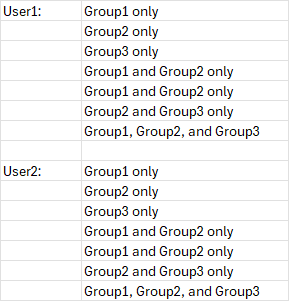 |
User1: Group1 only
User2: Group1 and Group2 only
You have a hybrid deployment of Azure Active Directory (Azure AD) that contains the users shown in the following table.
Name | Type | Source |
User1 | Member | Azure AD |
User2 | Member | Windows Server Active Directory |
User3 | Guest | Microsoft account  |
You need to modify the JobTitle and UsageLocation attributes for the users.
For which users can you modify the attributes from Azure AD? To answer, select the appropriate options in the answer area.
JobTitle: | User1 only |
User1 and User2 only | |
User1 and User3 only | |
User1, User2, and User3 | |
UsageLocation: | User1 only |
User1 and User2 only | |
User1 and User3 only | |
User1, User2, and User3 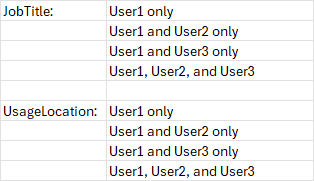 |
JobTitle: User1 and User3 only
UsageLocation: User1, User2, and User3
You need to ensure that an Azure Active Directory (Azure AD) user named Admin1 is assigned the required role to enable Traffic Analytics for an Azure subscription.
Solution: You assign the Network Contributor role at the subscription level to Admin1.
Does this meet the goal?
A. Yes
B. No
A. Yes
You need to ensure that an Azure Active Directory (Azure AD) user named Admin1 is assigned the required role to enable Traffic Analytics for an Azure subscription.
Solution: You assign the Owner role at the subscription level to Admin1.
Does this meet the goal?
A. Yes
B. No
A. Yes
You need to ensure that an Azure Active Directory (Azure AD) user named Admin1 is assigned the required role to enable Traffic Analytics for an Azure subscription.
Solution: You assign the Reader role at the subscription level to Admin1.
Does this meet the goal?
A. Yes
B. No
B. No
You have an Azure subscription that contains a user named User1.
You need to ensure that User1 can deploy virtual machines and manage virtual networks. The solution must use the principle of least privilege.
Which role-based access control (RBAC) role should you assign to User1?
A. Owner
B. Virtual Machine Contributor
C. Contributor
D. Virtual Machine Administrator Login
C. Contributor

You have an Azure Active Directory (Azure AD) tenant that contains three global administrators named Admin1, Admin2, and Admin3.
The tenant is associated to an Azure subscription. Access control for the subscription is configured as shown in the Access control exhibit. (Click the Access
Control tab.)
You sign in to the Azure portal as Admin1 and configure the tenant as shown in the Tenant exhibit. (Click the Tenant tab.)
For each of the following statements, select Yes if the statement is true. Otherwise, select No.
Admin1 can add Admin2 as an owner of the subscription
Admin3 can add Admin2 as an owner of the subscription
Admin2 can create a resource group in the subscription
No
Yes
No
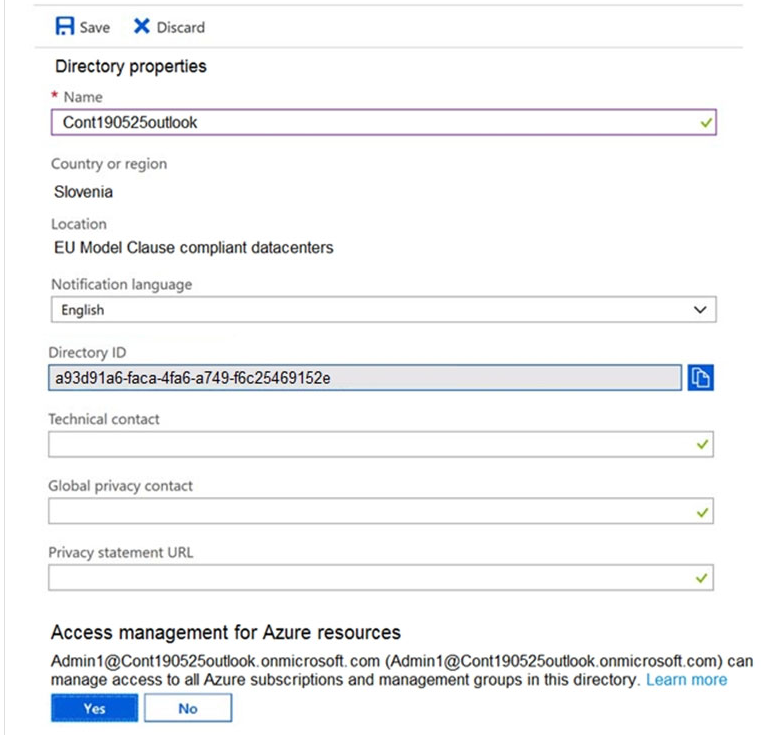
You have an Azure subscription named Subscription1 that contains an Azure virtual machine named VM1. VM1 is in a resource group named RG1.
VM1 runs services that will be used to deploy resources to RG1.
You need to ensure that a service running on VM1 can manage the resources in RG1 by using the identity of VM1.
What should you do first?
A. From the Azure portal, modify the Managed Identity settings of VM1
B. From the Azure portal, modify the Access control (IAM) settings of RG1
C. From the Azure portal, modify the Access control (IAM) settings of VM1
D. From the Azure portal, modify the Policies settings of RG1
A. From the Azure portal, modify the Managed Identity settings of VM1
You have an Azure subscription that contains a resource group named TestRG.
You use TestRG to validate an Azure deployment.
TestRG contains the following resources:
Name | Type | Description |
VM1 | Virtual Machine | VM1 is running and configured to back up to Vault1 daily |
Vault1 | Recovery Services Vault | Vault1 includes all backups of VM1 |
VNET1 | Virtual Network | VNET1 has a resource lock of type Delete  |
A. Modify the backup configurations of VM1 and modify the resource lock type of VNET1
B. Remove the resource lock from VNET1 and delete all data in Vault1
C. Turn off VM1 and remove the resource lock from VNET1
D. Turn off VM1 and delete all data in Vault1
B. Remove the resource lock from VNET1 and delete all data in Vault1
You have an Azure DNS zone named adatum.com.
You need to delegate a subdomain named research.adatum.com to a different DNS server in Azure.
What should you do?
A. Create an NS record named research in the adatum.com zone.
B. Create a PTR record named research in the adatum.com zone.
C. Modify the SOA record of adatum.com.
D. Create an A record named *.research in the adatum.com zone.
A. Create an NS record named research in the adatum.com zone.
You have an Azure Active Directory (Azure AD) tenant that has the contoso.onmicrosoft.com domain name.
You have a domain name of contoso.com registered at a third-party registrar.
You need to ensure that you can create Azure AD users that have names containing a suffix of @contoso.com.
Which three actions should you perform in sequence? To answer, move the appropriate actions from the list of actions to the answer area and arrange them in the correct order.
Add a record to the public contoso.com DNS zone
Add an Azure AD tenant
Configure company branding
Create an Azure DNS zone
Add a custom name
Verify the domain
You have an Azure subscription named Subscription1 that contains an Azure Log Analytics workspace named Workspace1.
You need to view the error events from a table named Event.
Which query should you run in Workspace1?
A. Get-Event Event | where {$_.EventType == "error"}
B. Event | search "error"
C. select * from Event where EventType == "error"
D. search in (Event) * | where EventType ג€"eq ג€errorג€
B. Event | search "error"
You have a registered DNS domain named contoso.com.
You create a public Azure DNS zone named contoso.com.
You need to ensure that records created in the contoso.com zone are resolvable from the internet.
What should you do?
A. Create NS records in contoso.com.
B. Modify the SOA record in the DNS domain registrar.
C. Create the SOA record in contoso.com.
D. Modify the NS records in the DNS domain registrar.
D. Modify the NS records in the DNS domain registrar.
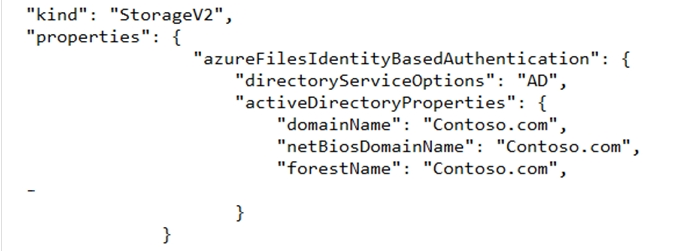
You have an Azure subscription that contains a storage account named storage1. The subscription is linked to an Azure Active Directory (Azure AD) tenant named contoso.com that syncs to an on-premises Active Directory domain.
The domain contains the security principals shown in the following table.
Name | Type |
User1 | User |
Computer1 | Computer |

In Azure AD, you create a user named User2.
The storage1 account contains a file share named share1 and has the following configurations.
For each of the following statements, select Yes if the statement is true. Otherwise, select No.
You can assign the Storage File Data SMB Share Contributor role to User1 for share1
You can assign the Storage File Data SMB Share Reader role to Computer1 for share1
You can assign the Storage File Data SMB Share Elevated Contributor role to User2 for share1
Yes
No
Yes
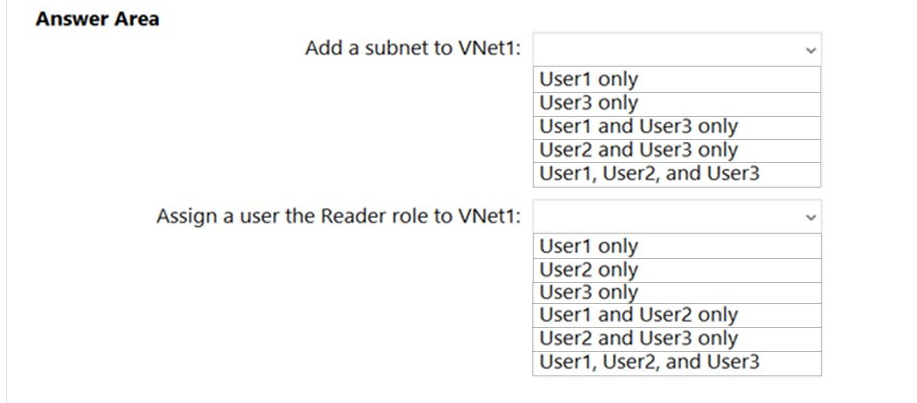
You have an Azure subscription named Subscription1 that contains a virtual network VNet1.
You add the users in the following table.
User | Role |
User1 | Owner |
User2 | Security Admin |
User3 | Network Contributor  |
Which user can perform each configuration? To answer, select the appropriate options in the answer area.
Add a subnet to VNet1:
Assign a user the Reader role to VNet1:
User1 and User3 only
Assign a user the Reader role to VNet1: User1 only
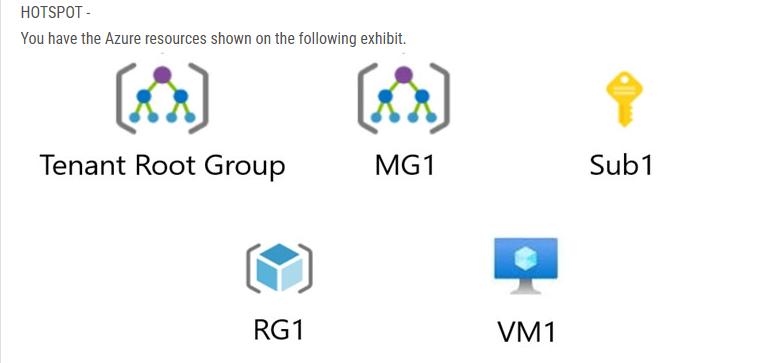
You plan to track resource usage and prevent the deletion of resources.
To which resources can you apply locks and tags? To answer, select the appropriate options in the answer area.
Locks:
Tags:
Sub1, RG1, and VM1 only
Sub1, RG1, and VM1 only
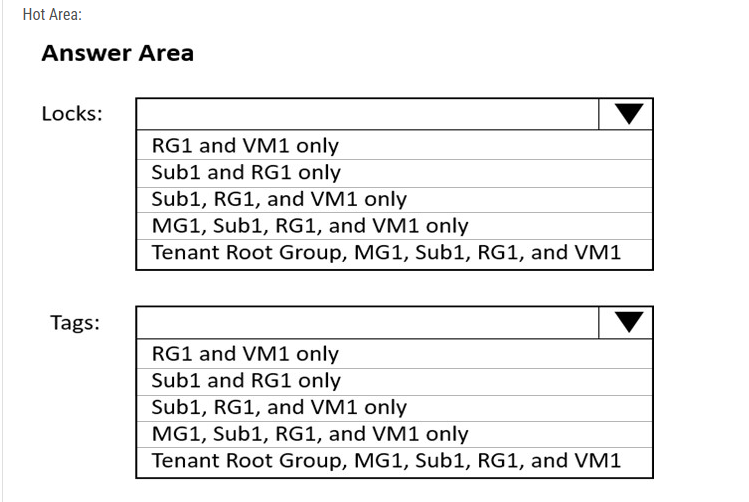
You have an Azure Active Directory (Azure AD) tenant.
You plan to delete multiple users by using Bulk delete in the Azure Active Directory admin center.
You need to create and upload a file for the bulk delete.
Which user attributes should you include in the file?
A. The user principal name and usage location of each user only
B. The user principal name of each user only
C. The display name of each user only
D. The display name and usage location of each user only
E. The display name and user principal name of each user only
B. The user principal name of each user only
You have an Azure subscription named Sub1 that contains the Azure resources shown in the following table.
Name | Type |
RG1 | Resource group |
storage1 | Storage account |
VNET1 | Virtual network  |
You assign an Azure policy that has the following settings:
✑ Scope: Sub1
✑ Exclusions: Sub1/RG1/VNET1
✑ Policy definition: Append a tag and its value to resources
✑ Policy enforcement: Enabled
✑ Tag name: Tag4
✑ Tag value: value4
You assign tags to the resources as shown in the following table.
Resource | Tag |
Sub1 | Tag1: subscription |
RG1 | Tag2: IT |
storage1 | Tag3: value1 |
VNET1 | Tag3: value2  |
For each of the following statements, select Yes if the statement is true. Otherwise, select No.
RG1 has the Tag2: IT tag assigned only
Storage1 has the Tag1: subscription, Tag2: IT, Tag3: value1, and Tag4: value4 tags assigned
VNET1 as the Tag2: IT and Tag3: value2 tags assigned only
No
No
No
You need to ensure that an Azure Active Directory (Azure AD) user named Admin1 is assigned the required role to enable Traffic Analytics for an Azure subscription.
Solution: You assign the Traffic Manager Contributor role at the subscription level to Admin1.
Does this meet the goal?
A. Yes
B. No
B. No
You have three offices and an Azure subscription that contains an Azure Active Directory (Azure AD) tenant.
You need to grant user management permissions to a local administrator in each office.
What should you use?
A. Azure AD roles
B. administrative units
C. access packages in Azure AD entitlement management
D. Azure roles
B. administrative units
You have an Azure Directory (Azure AD) tenant named Adatum and an Azure Subscription named Subscription1. Adatum contains a group named Developers.
Subscription1 contains a resource group named Dev.
You need to provide the Developers group with the ability to create Azure logic apps in the Dev resource group.
Solution: On Dev, you assign the Logic App Contributor role to the Developers group.
Does this meet the goal?
A. Yes
B. No
A. Yes
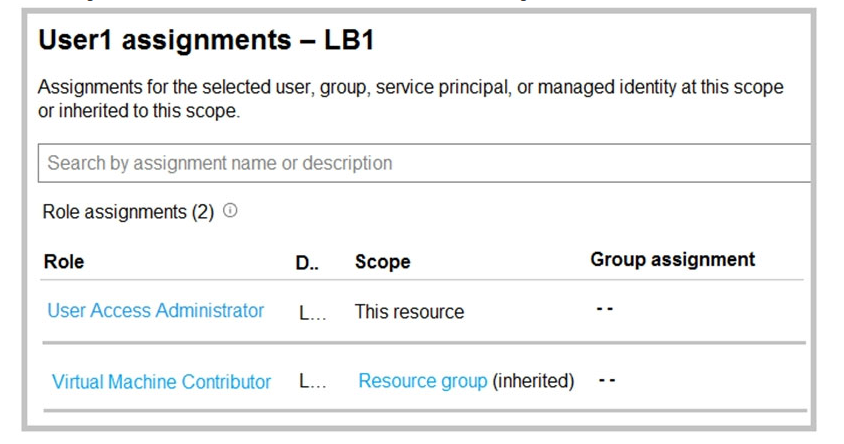
You have an Azure Load Balancer named LB1.
You assign a user named User1 the roles shown in the following exhibit.
Use the drop-down menus to select the answer choice that completes each statement based on the information presented in the graphic.
User1 can _______ LB1
delete
create a NAT rule for
assign access to other users for
User1 ________ the resource group
delete a virtual machine from
modify the load balancing rules in
deploy an Azure Kubernetes Services (AKS) cluster to
User1 can assign access to other users for LB1
User1 delete a virtual machine from the resource group
You have an Azure subscription named Subscription1 that contains a virtual network named VNet1. VNet1 is in a resource group named RG1.
Subscription1 has a user named User1. User1 has the following roles:
✑ Reader
✑ Security Admin
✑ Security Reader
You need to ensure that User1 can assign the Reader role for VNet1 to other users.
What should you do?
A. Remove User1 from the Security Reader role for Subscription 1. Assign User1 the Contributor role for RG1
B. Assign User1 the Owner role for VNet1
C. Assign User1 the Contributor role for VNet1
D. Assign User1 the Network Contributor role for VNet1
B. Assign User1 the Owner role for VNet1
![<p>You configure the custom role shown in the following exhibit.<br></p><p>Use the drop-down menus to select the answer choice that completes each statement based on the information presented in the graphic.<br></p><p>To ensure that users can sign in to virtual machines that are assigned role1, modify the <strong>[answer choice]</strong> section</p><p>actions</p><p>roletype</p><p>notActions</p><p>dataActions</p><p>notDataActions</p><p>assignableScopes</p><p></p><p>To ensure that role1 can only be assigned only to a resource group named RG1, modify the <strong>[answer choice]</strong> section</p><p>actions</p><p>roletype</p><p>notActions</p><p>dataActions</p><p>notDataActions</p><p>assignableScopes</p>](https://knowt-user-attachments.s3.amazonaws.com/7d06d41d-a99a-4aca-a85d-32c9a3d9b691.png)
You configure the custom role shown in the following exhibit.
Use the drop-down menus to select the answer choice that completes each statement based on the information presented in the graphic.
To ensure that users can sign in to virtual machines that are assigned role1, modify the [answer choice] section
actions
roletype
notActions
dataActions
notDataActions
assignableScopes
To ensure that role1 can only be assigned only to a resource group named RG1, modify the [answer choice] section
actions
roletype
notActions
dataActions
notDataActions
assignableScopes
roletype
assignableScopes
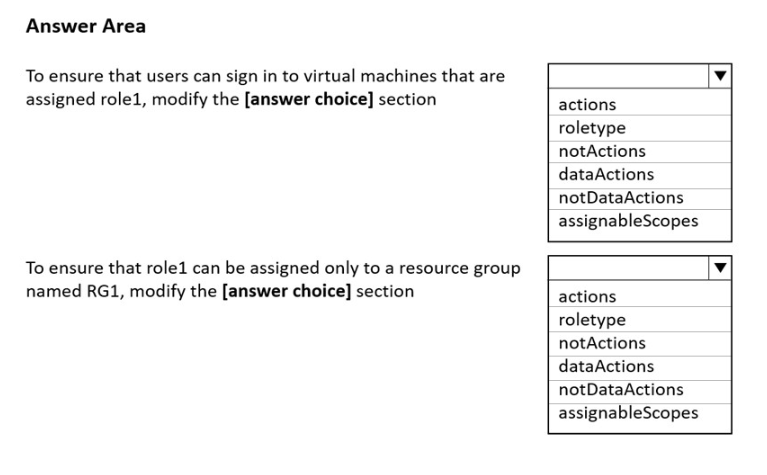
You have an Azure subscription that contains a storage account named storage1. The storage1 account contains a file share named share1.
The subscription is linked to a hybrid Azure Active Directory (Azure AD) tenant that contains a security group named Group1.
You need to grant Group1 the Storage File Data SMB Share Elevated Contributor role for share1.
What should you do first?
A. Enable Active Directory Domain Service (AD DS) authentication for storage1
B. Grant share level permissions by using File Explorer
C. Mount share1 by using File Explorer
D. Create a private endpoint
A. Enable Active Directory Domain Service (AD DS) authentication for storage1
You have 15 Azure subscriptions.
You have an Azure Active Directory (Azure AD) tenant that contains a security group named Group1.
You plan to purchase additional Azure subscription.
You need to ensure that Group1 can manage role assignments for the existing subscriptions and the planned subscriptions. The solution must meet the following requirements:
✑ Use the principle of least privilege.
✑ Minimize administrative effort.
What should you do?
A. Assign Group1 the Owner role for the root management group
B. Assign Group1 the User Access Administrator role for the root management group
C. Create a new management group and assign Group1 the User Access Administrator role for the group
D. Create a new management group and assign Group1 the Owner role for the group
B. Assign Group1 the User Access Administrator role for the root management group
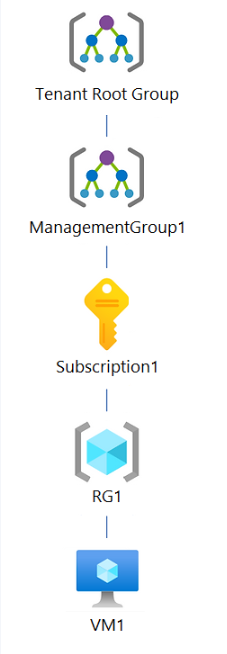
You have an Azure subscription that contains the hierarchy shown in the following exhibit.
You create an Azure Policy definition named Policy1.
To which Azure resources can you assign Policy1 and which Azure resources can you specify as exclusions from Policy1? To answer, select the appropriate options in the answer area.
You can assign Policy1 to:
Subscription1 and RG1 only
ManagementGroup1 and Subscription
Tenant Root Group, ManagementGroup1, and Subscription1 only
Tenant Root Group, ManagementGroup1, Subscription1, and RG1 only
Tenant Root Group, ManagementGroup1, Subscription1, RG1, and VM1
You can exclude Policy1 from:
VM1 only
RG1 and VM1 only
Subscription1, RG1, and VM1 only
ManagementGroup1, Subscription1, RG1, and VM1 only
Tenant Root Group, ManagementGroup1, Subscription1, RG1, and VM1
Tenant Root Group, ManagementGroup1, Subscription1, and RG1 only
ManagementGroup1, Subscription1, RG1, and VM1 only
You have an Azure subscription that contains the following users in an Azure Active Directory tenant named contoso.onmicrosoft.com:
Name | Role | Scope |
User1 | Global administrator | Azure Active Directory |
User2 | Global administrator | Azure Active Directory |
User3 | User administrator | Azure Active Directory |
User4 | Owner | Azure Subscription  |
User1 creates a new Azure Active Directory tenant named external.contoso.onmicrosoft.com.
You need to create new user accounts in external.contoso.onmicrosoft.com.
Solution: You instruct User2 to create the user accounts.
Does that meet the goal?
A. Yes
B. No
A. Yes
You have an Azure subscription that contains the following users in an Azure Active Directory tenant named contoso.onmicrosoft.com:
Name | Role | Scope |
User1 | Global administrator | Azure Active Directory |
User2 | Global administrator | Azure Active Directory |
User3 | User administrator | Azure Active Directory |
User4 | Owner | Azure Subscription  |
User1 creates a new Azure Active Directory tenant named external.contoso.onmicrosoft.com.
You need to create new user accounts in external.contoso.onmicrosoft.com.
Solution: You instruct User4 to create the user accounts.
Does that meet the goal?
A. Yes
B. No
B. No
You have an Azure subscription that contains the following users in an Azure Active Directory tenant named contoso.onmicrosoft.com:
Name | Role | Scope |
User1 | Global administrator | Azure Active Directory |
User2 | Global administrator | Azure Active Directory |
User3 | User administrator | Azure Active Directory |
User4 | Owner | Azure Subscription  |
User1 creates a new Azure Active Directory tenant named external.contoso.onmicrosoft.com.
You need to create new user accounts in external.contoso.onmicrosoft.com.
Solution: You instruct User3 to create the user accounts.
Does that meet the goal?
A. Yes
B. No
B. No
You have two Azure subscriptions named Sub1 and Sub2.
An administrator creates a custom role that has an assignable scope to a resource group named RG1 in Sub1.
You need to ensure that you can apply the custom role to any resource group in Sub1 and Sub2. The solution must minimize administrative effort.
What should you do?
A. Select the custom role and add Sub1 and Sub2 to the assignable scopes. Remove RG1 from the assignable scopes
B. Create a new custom role for Sub1. Create a new custom role for Sub2. Remove the role from RG1
C. Create a new custom role for Sub1 and add Sub2 to the assignable scopes. Remove the role from RG1
D. Select the custom role and add Sub1 to the assignable scopes. Remove RG1 from the assignable scopes. Create a new custom role for Sub2.
A. Select the custom role and add Sub1 and Sub2 to the assignable scopes. Remove RG1 from the assignable scopes